|
Happy Halloween! Halloween is a holiday that makes light of
the dark side of life. We all joke about mummies, coffins, and burial as we
chew sweet treats. However, it can be quite hard to talk about death and
burial outside of Halloween jokes! That’s why we are going to hit the topic
head on, from an environmental perspective, and give you some food for thought
about funerals, burials, cremation, and some green alternatives.
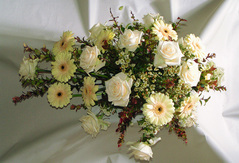
What's the issue?
Conventional American funerals,
burials, and cremations can be resource-intensive and polluting. According
to the Funeral Consumers Alliance of Minnesota, cemeteries across the U.S. each
year bury:
- 827,060 gallons of embalming fluid (includes
formaldehyde)
- 2,700
tons of copper and bronze (caskets)
- 30
million board feet of hardwoods (caskets)
- 1,600,000
tons of reinforced concrete (vaults)
- 14,000
tons of steel (vaults)
The mining, manufacture, and transport of these materials creates air emissions, as does cemetery mowing and upkeep. Chemicals used to maintain cemetery grounds can pollute lakes and streams. Irrigation to keep cemetery grounds green uses a
lot of water, a finite resource.
Flame-based cremation has some environmental advantages over burial (fewer natural resources are used), but is energy intensive. In addition, trace metals like mercury can be released to the atmosphere
during the cremation process, along with other emissions.
Faced with this information, what’s a mere mortal to do?
|
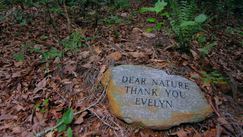 Fortunately, Minnesotans have an expanding number of eco-friendly death care options.
Start by asking prospective funeral homes what their internal green
business practices are and what green funeral
choices they offer (this approach can be especially useful if developing a future plan).
Minnesota rules and regulations pertaining to green funerals and burials have been evolving in recent years. One of the best resources is the document “Choices” published by the Minnesota Department of Health. Among other things, it provides a useful definition of green funerals
and burials.
|
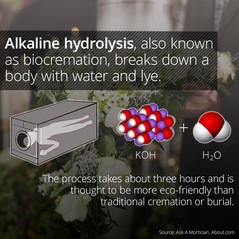 Green cremation
Originally pioneered in Minnesota by the Mayo Clinic, alkaline hydrolysis, also known as biocremation or green cremation, is an
alternative to flame-based cremation.
Green cremation uses water, an alkali
solution of potassium hydroxide (lye), heat, and pressure to reduce a body to bone
ash. Because it is not flame based, the process uses less energy than
conventional cremation.
The Funeral Consumers Alliance of Minnesota’s website provides information on green
cremation and where it's offered in Minnesota.
|
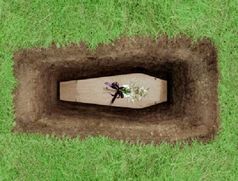 Green burial
The Green Burial
Council (GBC) identifies green or natural burial as a way of caring for the dead
that reduces carbon emissions, protects worker health, helps conserve natural
resources, and restores or preserves habitat.
Green burial prohibits embalming of the deceased.
Biodegradable caskets, urns, or shrouds made from nontoxic, sustainably harvested
materials take the place of concrete vaults and metal caskets.
Minnesota law does not require embalming except under certain
circumstances, nor does it require the use of burial vaults, although some
cemeteries do. See "Choices" for more information.
Green cemeteries
The Green Burial Council certifies the following three
categories of green cemeteries:
-
Hybrid
burial grounds are conventional cemeteries that offer the option of burial
without a vault, concrete slab, or outer container of any kind. Hybrid burial
grounds must allow for any kind of burial container, including shrouds.
-
Natural burial grounds must meet all the requirements of hybrid burial grounds. In
addition, they must have an Integrated Pest Management program in place,
practice sustainable landscaping techniques, and adopt
practices/protocols that are energy-conserving,
minimize waste, and do not require
the use of toxic chemicals
-
Conservation burial grounds must meet all of the requirements for hybrid and natural burial grounds. In addition, they must protect in perpetuity an area of land
specifically and exclusively designated for conservation.
GBC-certified funeral homes and burial sites in Minnesota can be found at greenburialcouncil.org.
Greening the event
Funeral ceremonies can generate a lot of garbage. Here are some
ways to lower the impacts.
-
Forgo flowers. Funeral flowers may be
grown using pesticides and other chemicals. In lieu of flowers, ask friends and
family to donate to a favorite charity. If flowers are a must-have item, request
or source locally grown organic varieties.
-
Make sustainable food choices. If food is
part of the event, specify locally sourced items. Reduce waste by using
reusable dishware and utensils.
-
Travel green. Encourage attendees to
carpool or take public transit to and from funeral events to cut down on fossil fuel
use and emissions.Some funeral directors offer web-based video conferencing for friends and family who cannot travel.
|
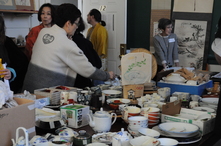
After the funeral
Sorting through and deciding what to do with a deceased
loved one's belongings can be challenging. Practicing the “4 Rs”—reduce, reuse,
repurpose, and recycle—can help with this difficult task.
Even items that seem hopelessly dated or worn may
still have value and reuse potential. An estate sale is a good way to
find new homes for things. If you’re planning to involve an estate liquidator,
be sure to first check out the Minnesota
Attorney General’s guidelines for hiring one.
Hold off on the dumpster until after the sale, as estate sales need inventory to be
successful! Donate things that don’t sell to charity organizations. Reduce.org has some
great tips and resources for what to do with estate “left-overs”.
Feeling overwhelmed by all the “stuff”? A professional
organizer may be worth engaging to help sort through things--some even
specialize in estate clean-out! The National
Association of Professional Organizers offers suggestions and resources for
finding the right individual or company.
Give sympathy cards a second life via
repurposing! Check with local nursing homes and assisted living facilities, or
youth organizations, to see if they accept card fronts for their craft
projects. Or, you can send them to St. Jude’s
Ranch for Children for use in their Recycled Card Program.
|
Resources
Join your neighbors in attending a public "convening" on the local impacts
of climate change, co-hosted by Climate Generation and the University
of Minnesota Regional Sustainable Development Partnerships. Hear from
experts, community leaders, and storytellers about local climate issues.
Work with neighbors, friends, and colleagues to implement innovative
local solutions. Free and open to the public, ALL ages welcome.
- Climate Minnesota: Detroit Lakes convening, November 2 @ 8:30 am - 12 pm
- Climate Minnesota: Brainerd Convening, November 2 @ 5:30 pm - 9 pm
- Climate Minnesota: West Metro Convening, November 12 @ 5:30 pm - 9 pm
For more information to to register, visit Climate Generation.
Kick off the holiday season
with Do It Green! Minnesota’s 10th Annual Green
Gifts Fair on Saturday, November 21, 10am - 5pm at
Midtown Global Market on Lake Street and 10th Avenue in Minneapolis. The Green Gifts Fair is a fun, family-friendly event with an estimated
attendance of 6,000. A $1 donation will be accepted at the doors.
HIGHLIGHTS OF THE FAIR
-
Many new and unique vendors
- First 100 visitors receive a Chinook Book mobile app
-
Free Green Living booklet
-
Go car-less booth with free bike tune-ups
-
Food samples
-
Family passport activities with prizes
-
Live music
-
Silent auction
Thank you for reading Living
Green 365. This newsletter is a publication of the Minnesota Pollution Control
Agency. Please send questions or comments about living green to the address
below.
Sincerely,
Erin Barnes-Driscoll and the Living Green Team
livinggreen365.pca@state.mn.us
|